Special Report
America's Most (and Least) Religious States
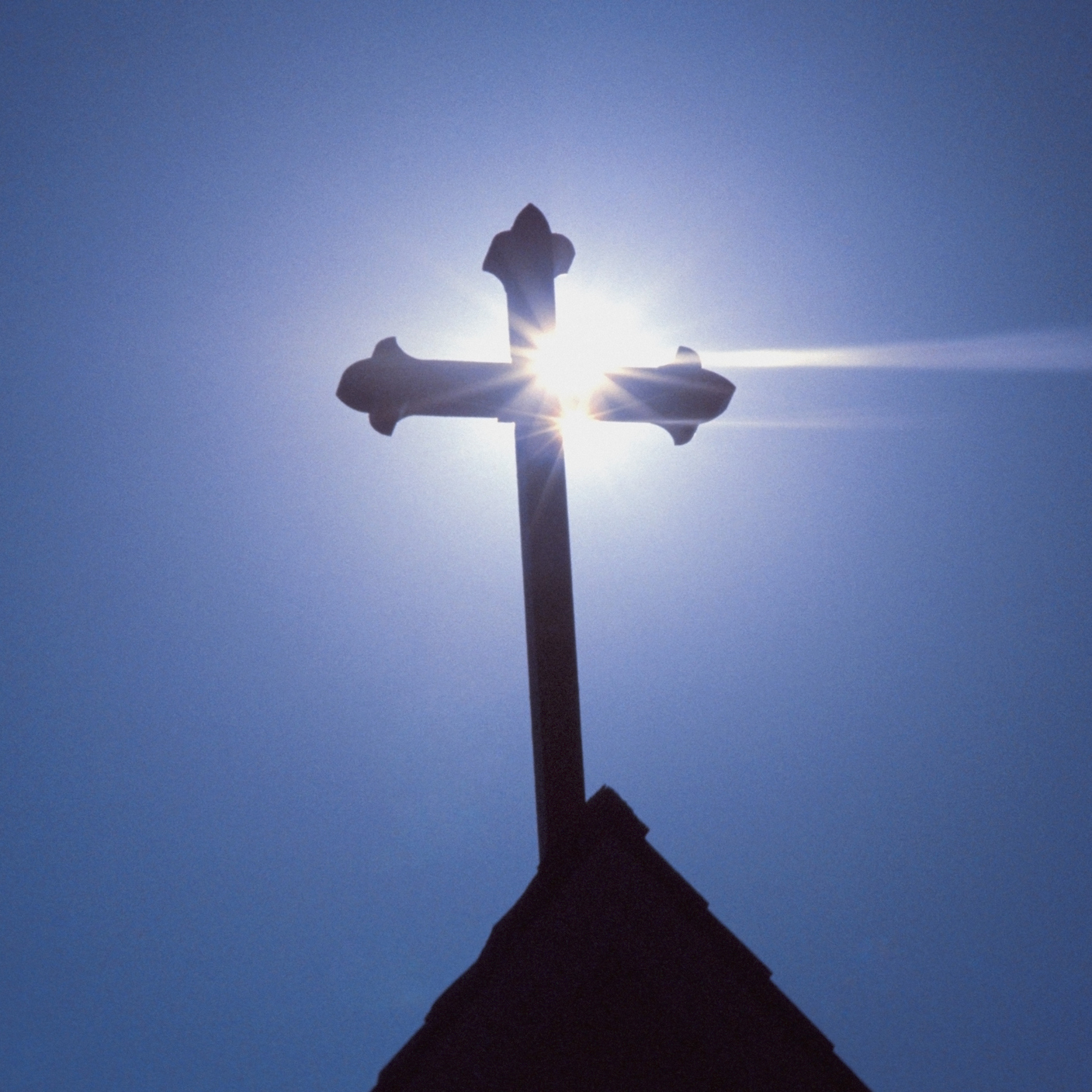
Published:
Last Updated:

Across America, states and regions differ in terms of their cultures, foods and accents. But one of the biggest distinguishing features is how religion impacts the people of each place.
While religion is widespread across the country, the share of adults for whom religion is extremely important to their lives varies greatly between states. In the most religious state, 77% of the population are highly religious compared with 33% in the least religious.
Christianity is by far the most common religion in the United States, with 70% of Americans identifying as Christian. To break it down further, 25% or Americans are evangelical, 21% are Catholic, 15% are mainline Protestant, and 6% are Protestant. States that are more evangelical tend to be more deeply religious overall.
Despite the high levels of Christianity, the fastest-growing religious affiliation is actually no religion at all. The percentage of adults who are religiously unaffiliated adults grew in every state except for one, and it was the fastest growing ideology in almost every state for which there was data.
24/7 Wall St. reviewed a 2014 Pew Research Center survey of all 50 states and their religious makeup. Using data from Pew, 24/7 Wall St. ranked states based on how highly religious their populations are. The study also determined the importance of religion residents’ lives, worship attendance, frequency of prayer, and the belief in God.
To identify the most and least religious states, 24/7 Wall St. reviewed a 2014 Pew Research Center survey of all 50 states and their religious makeup. Using data from Pew, 24/7 Wall St. ranked states based on how highly religious their populations are. Religion’s importance in one’s life, worship attendance, frequency of prayer, and the belief in God were also used in the determination. Trends were determined by comparing the percentage of adherents to the religion in a previous survey conducted in 2007. Pew surveyed more than 35,000 Americans. 24/7 Wall st. reviewed median age and the percentage of residents 65 and over from the American Community Survey.
Click here to see the most religious states.
Click here to see the least religious states.
The Most Religious States
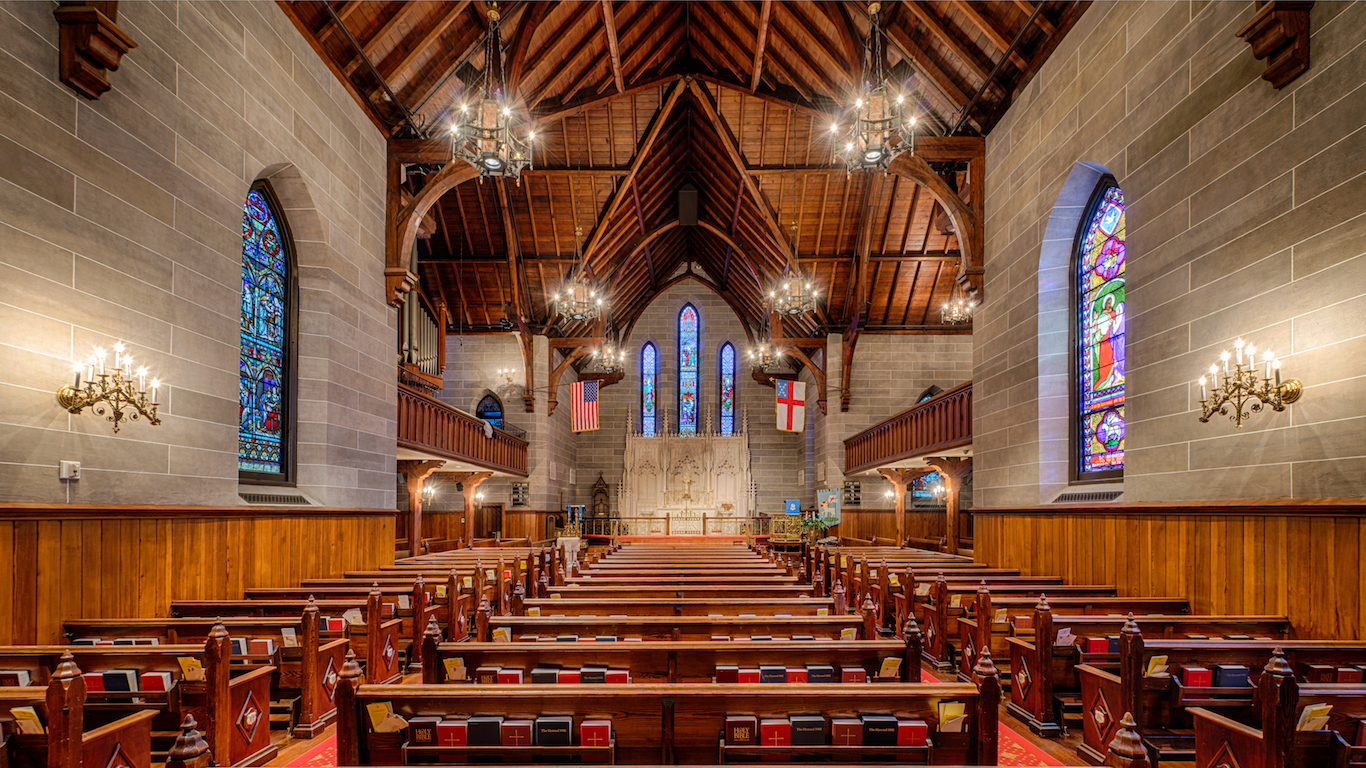
10. North Carolina
> Adults who are “highly” religious: 65%
> Pct. of adults who pray daily: 66%
> Change, nonreligious share of population: +8 ppts
As with many other states, North Carolina’s religious population largely consists of evangelical Christians. Some 35% of adults in the state are evangelical, the 10th highest percentage in the country.
North Carolina also has one of the highest Protestant Christian populations. Some 12% of its population identifies as Protestant, which is double the national share.
[in-text-ad]

9. Oklahoma
> Adults who are “highly” religious: 66%
> Pct. of adults who pray daily: 65%
> Change, nonreligious share of population: +6 ppts
Most Oklahoma adults consider their religion to be an important part of their lives, with most expressing their religion through prayer — 65% of adults pray every day. Some 47% of Oklahoma adults are evangelical, which is a higher than share than in all but a handful of states.
While the percentage of evangelical residents in the state is high, it used to be higher. In 2007, Oklahoma was the most evangelical state in the country as 53% of its adult residents identify as evangelical.
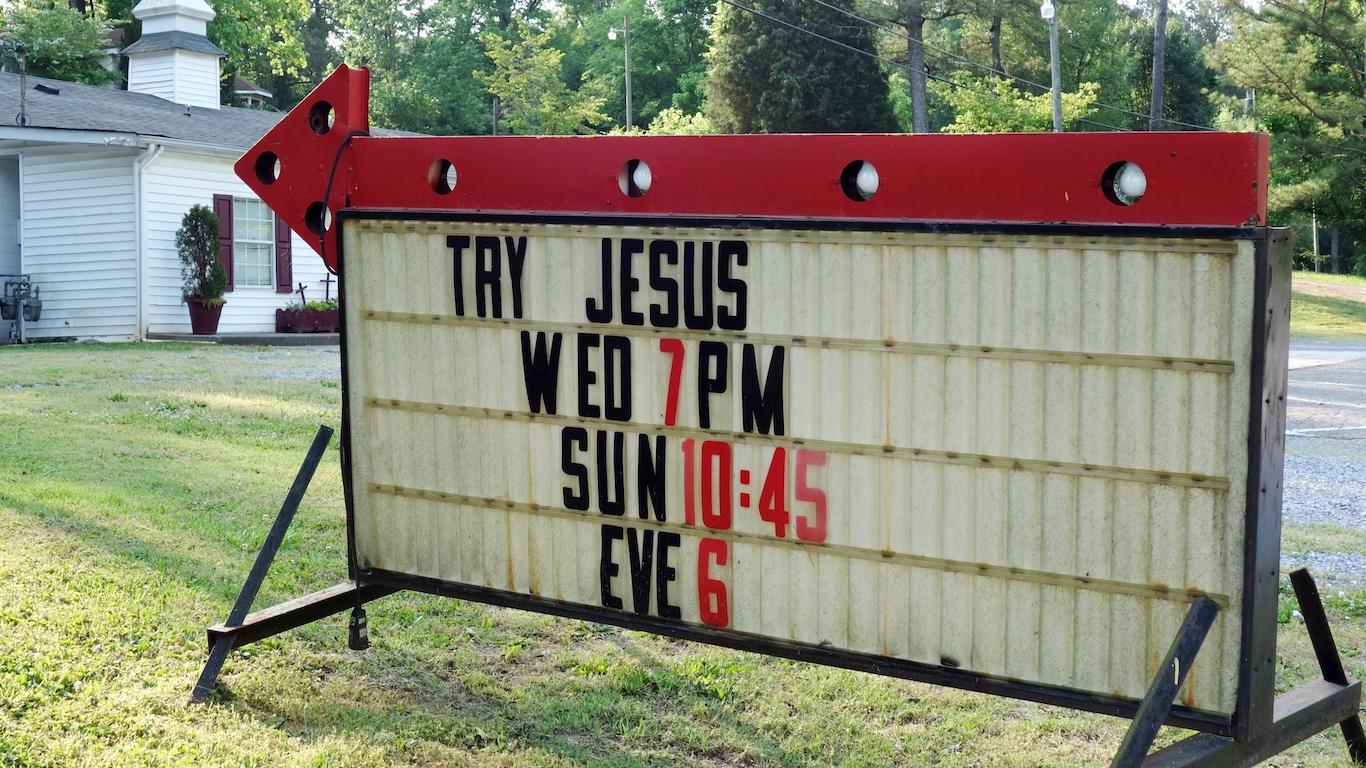
8. Georgia
> Adults who are “highly” religious: 66%
> Pct. of adults who pray daily: 64%
> Change, nonreligious share of population: +5 ppts
With a large evangelical and Protestant population, 79% of Georgia adults identify as Christians, one of the five highest percentages in the country. However, that is a drop from the estimated 84% of adults who were Christian in 2007. Some 64% of Georgia adults say religion is very important to them and 74% believe in God with absolute certainty, both figures are in the top 10 among states.
The state is also among the 10 youngest in America, with a median age of 36.5 years old. Georgia is very religious, even though young people tend to be less likely to have a religious affiliation.
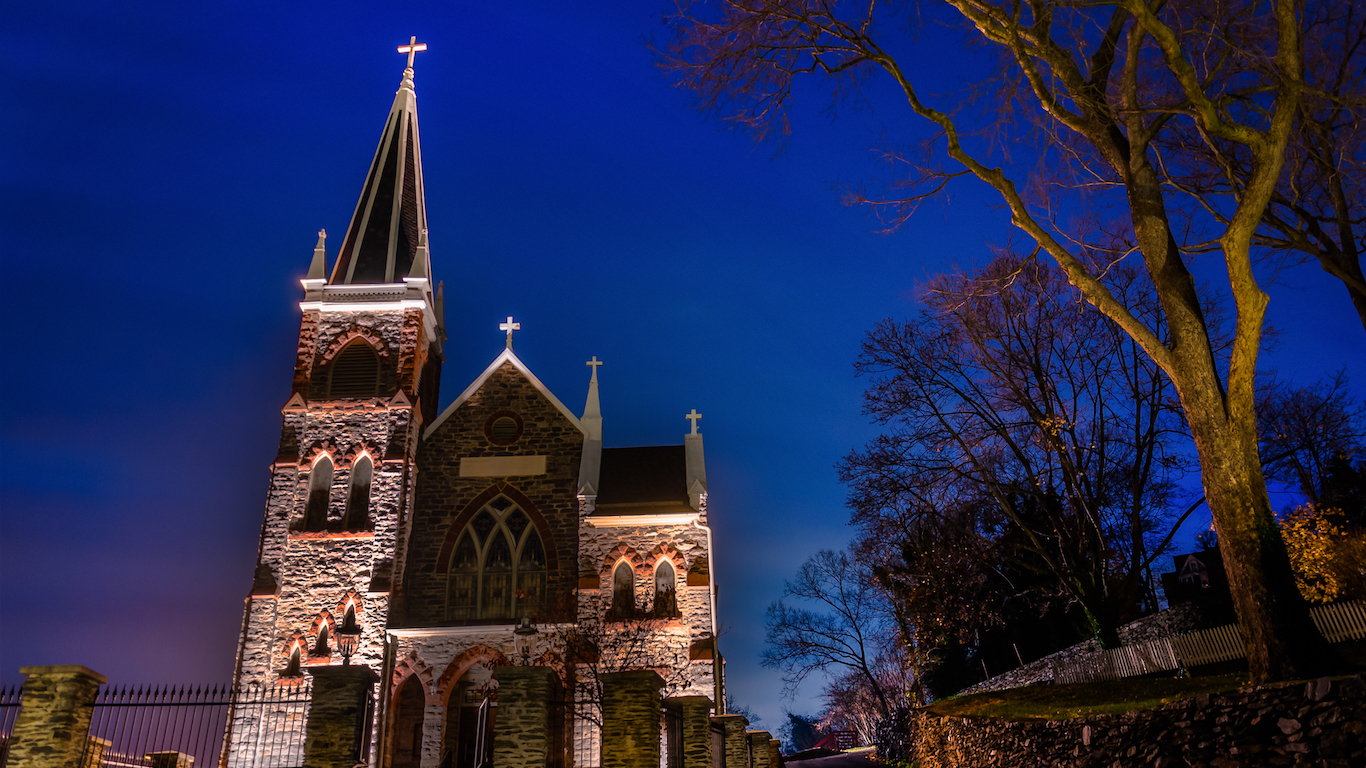
7. West Virginia
> Adults who are “highly” religious: 69%
> Pct. of adults who pray daily: 68%
> Change, nonreligious share of population: -1 ppts
The share of religious adults in all states is shrinking — with one exception. West Virginia is the only state where the percentage of nonreligious adults actually declined from 2007 to 2014.
The growth in the state’s religious population is largely attributable to the 3 percentage point increase West Virginia saw in its evangelical population, from 36% to 39%. West Virginia also has the third highest percentage of adults who are mainline Christians at 29%.
[in-text-ad-2]
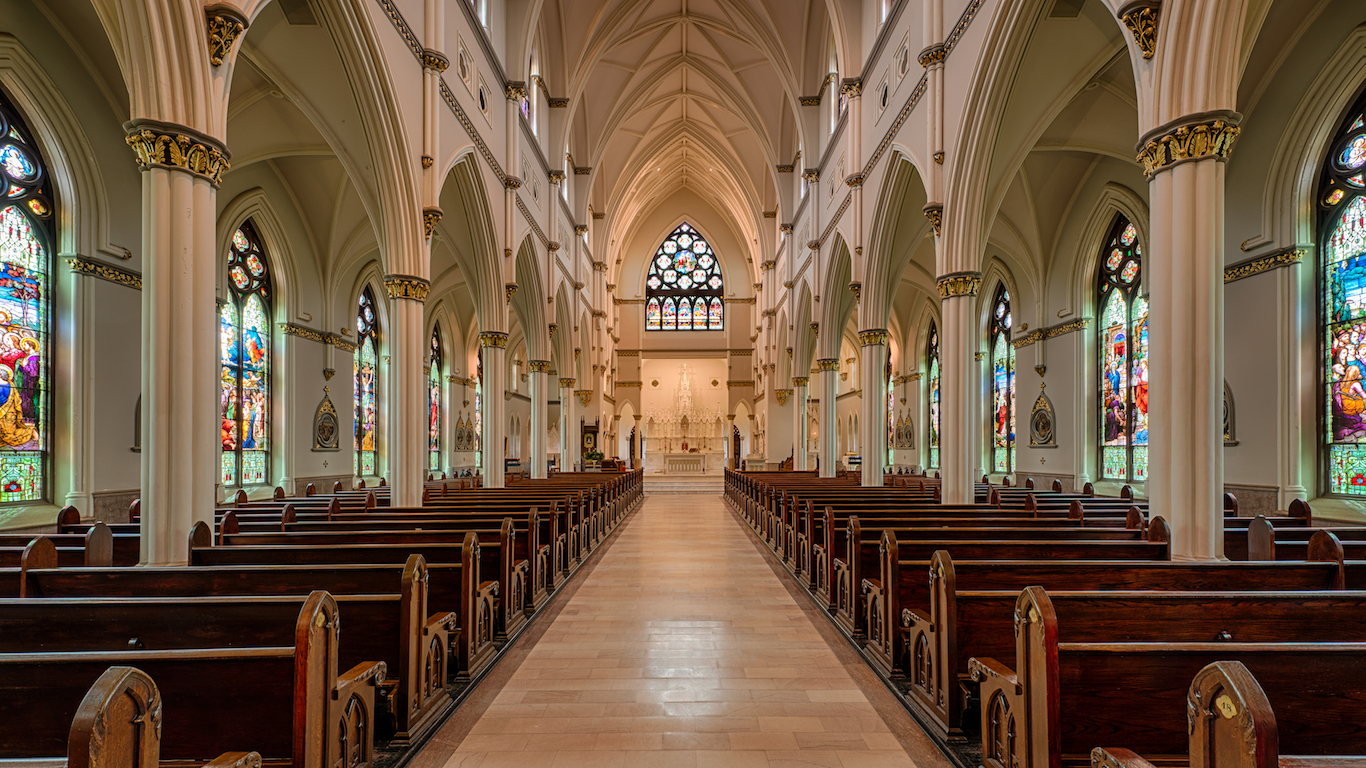
6. South Carolina
> Adults who are “highly” religious: 70%
> Pct. of adults who pray daily: 66%
> Change, nonreligious share of population: +9 ppts
Because South Carolina is tucked firmly in the Bible Belt, it should come as no surprise that Christianity is the most prevalent religion. While most adults in South Carolina are evangelical, more than 10% of the state’s adults also describe themselves as mainline Protestants and Catholic — one of the only states where that is the case. However, a significant drop in religiosity occurred between 2007 and 2014, when the percentage of adults who consider themselves religious dropped from 90% to 81%. With this in mind, South Carolina still has some of the highest sermon attendance in the country, with nearly 47% of adults saying they attend worship services weekly.

5. Arkansas
> Adults who are “highly” religious: 70%
> Pct. of adults who pray daily: 65%
> Change, nonreligious share of population: +5 ppts
Some 46% of Arkansas residents identify as evangelical, the fifth highest share of all states. The state also has the 10th highest share of Protestant population at 8%. These two high shares helped vault the state into the top five most religious states.
Some 2% of Arkansas adults are Muslim, the second highest Muslim population among the 25 states with data provided on Muslim residents.
[in-text-ad]

4. Louisiana
> Adults who are “highly” religious: 71%
> Pct. of adults who pray daily: 68%
> Change, nonreligious share of population: +5 ppts
Louisiana has a higher percentage of adults who consider themselves religious than anywhere else in the country. An estimated 87% of adults in the state adhere to some religious ideology. The largest ideology is evangelical, at 27% of the population. Protestants are second at 22% of the population and have the second-largest share of all states. Some 75% of Pelican State residents believe in God with absolute certainty, a higher percentage than all but five other states.

3. Tennessee
> Adults who are “highly” religious: 73%
> Pct. of adults who pray daily: 70%
> Change, nonreligious share of population: +2 ppts
The third most religious state, Tennessee is also the most evangelical state in the country as over half of its residents — 52% — are evangelical Christians. Tennessee is also one of just four states where more than half of residents say they worship at least once a week.
Like many other southern states, most adults in Tennessee say they pray every day and consider religion very important in their lives. And with just a 2% increase in the nonreligious population, adults are sticking with their faith in Tennessee more than in almost any other state.

2. Alabama
> Adults who are “highly” religious: 77%
> Pct. of adults who pray daily: 73%
> Change, nonreligious share of population: +4 ppts
Alabama narrowly missed out being the most religious state in the country, but it is still near the top in many religious metrics. The state has the highest share of adults who consider themselves religious and the highest percentage of Christians among states.
Alabama also has the highest percentage of adults who say religion is very important in their lives at 77%. It is also tied for the highest percentage of adults who believe in God with absolute certainty at 82%.
[in-text-ad-2]

1. Mississippi
> Adults who are “highly” religious: 77%
> Pct. of adults who pray daily: 75%
> Change, nonreligious share of population: +8 ppts
What makes Mississippi the most religious state in America is not only the percentage of adults who consider themselves highly religious but the practice of religion. While tied with Alabama as the state for the highest percentage of adults who believe in God with absolute certainty, 75% of Mississippians report praying daily — the highest share in the country. Mississippi has the highest percentage of Protestants in the country at 24%. However, religiosity in the state might be changing. The state’s nonreligious population as a share of the total population has increased faster than in any other state.
The Least Religious States

10. Colorado
> Adults who are “highly” religious: 47%
> Pct. of adults who pray daily: 50%
> Change, nonreligious share of population: +4 ppts
In Colorado, 67% of adults consider themselves religious. That’s fewer than just three other states in the U.S. Also, 30% of state adults claim they attend worship services on at least a weekly basis, one of the lower percentages in the country as well. However, the group of nonreligious adults in Colorado increased 4 percentage points in 2014 from 2007, which is below the average 6 percentage point jump by state.
[in-text-ad]
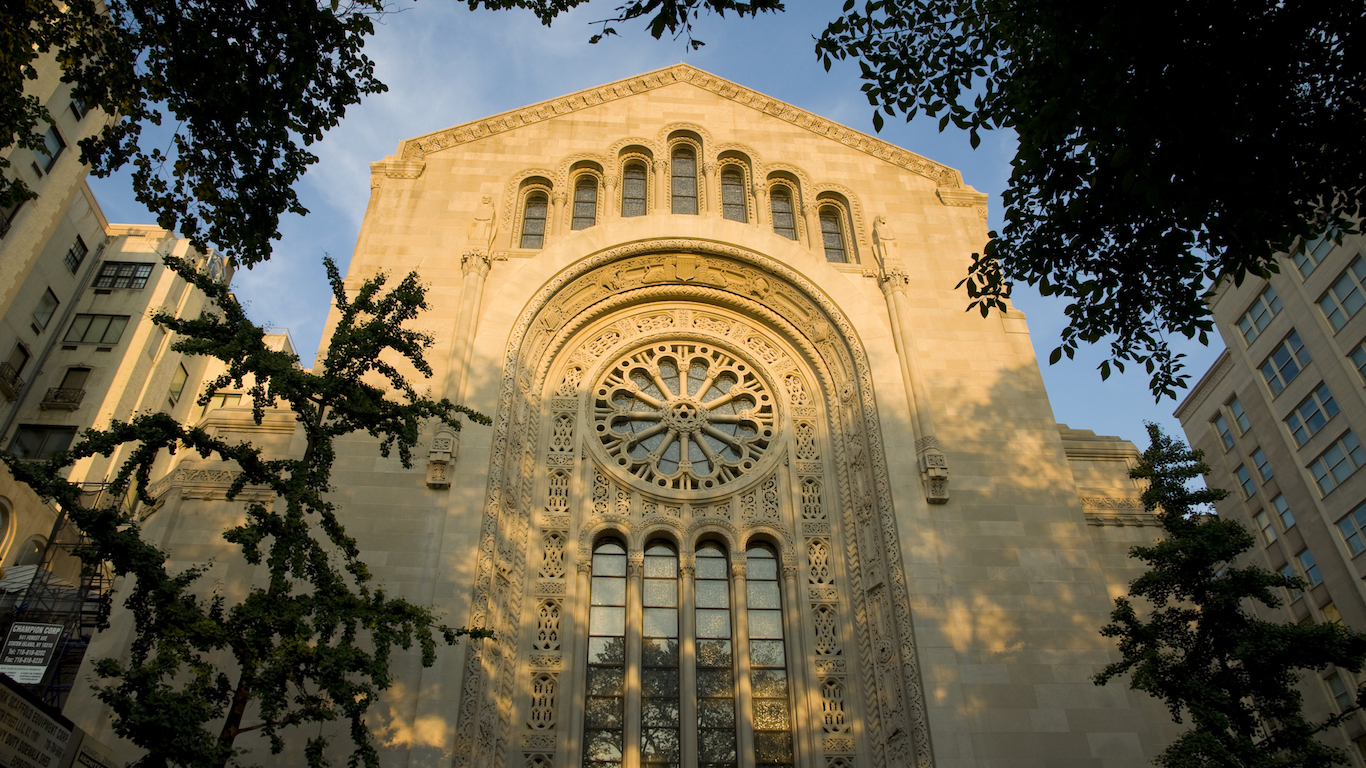
9. New York
> Adults who are “highly” religious: 46%
> Pct. of adults who pray daily: 48%
> Change, nonreligious share of population: +10 ppts
An estimated 72% of New Yorkers consider themselves religious, below the U.S. average of 77%. New York is home to the largest Jewish population in the country, with 7% of its adults identifying as Jewish. The state also has a sizeable Catholic population, at 31%. However, there has been a movement away from organized religion,with a 10-percentage point increase of New Yorkers claiming to be unaffiliated from 2007 to 2014.

8. Wisconsin
> Adults who are “highly” religious: 45%
> Pct. of adults who pray daily: 46%
> Change, nonreligious share of population: +9 ppts
In Wisconsin, there has been a relatively sizable increase in the percentage of its residents who consider themselves nonreligious. The state’s religiously unaffiliated population grew by 9 percentage points from 2007 to 2014, making it Wisconsin’s fastest growing segment.
Like all other states, Christianity is the most common religion in Wisconsin. But there is no one denomination that dominates the state. Wisconsin is 25% Catholic, 22% evangelical and 18% mainline Christian.

7. Alaska
> Adults who are “highly” religious: 45%
> Pct. of adults who pray daily: 49%
> Change, nonreligious share of population: +4 ppts
While the last frontier has always been less religious by U.S. standards, the decline in faith continues. From 2007 to 2014, the share of Alaskans who consider themselves nonreligious increased by three percentage points. The state has a sizeable and growing Mormon and Orthodox Christian population, with the latter being the largest share of the population in the country.
[in-text-ad-2]

6. Washington
> Adults who are “highly” religious: 45%
> Pct. of adults who pray daily: 46%
> Change, nonreligious share of population: +9 ppts
As you may expect for one of the least religious states in the country, spirituality is not a part of many of the daily lives of Washington residents. Only 44% of adults there say religion is very important to them, and only 46% say they pray daily, some of the lowest percentages in the country. Additionally, 30% of Washingtonians go to a worship service on a weekly basis, fewer than most other states. Even so, most adults still think there is a higher power. Some 55% of adults believe in God with absolute certainty.

5. Connecticut
> Adults who are “highly” religious: 43%
> Pct. of adults who pray daily: 47%
> Change, nonreligious share of population: +1 ppts
Even though an estimated 79% of Connecticut adults affiliate themselves with a religion, only 43% see themselves as highly religious. Connecticut has a growing Jewish population, rising to 3% of the population in 2014 from 1% in 2007. However, its fastest growing ideologies are evangelical and mainline Protestant. Still, the majority of adults in Connecticut do not deeply depend on religion, with only 42% of adults claiming it is important in their lives. That percentage is lower than all but a handful of other states.
[in-text-ad]
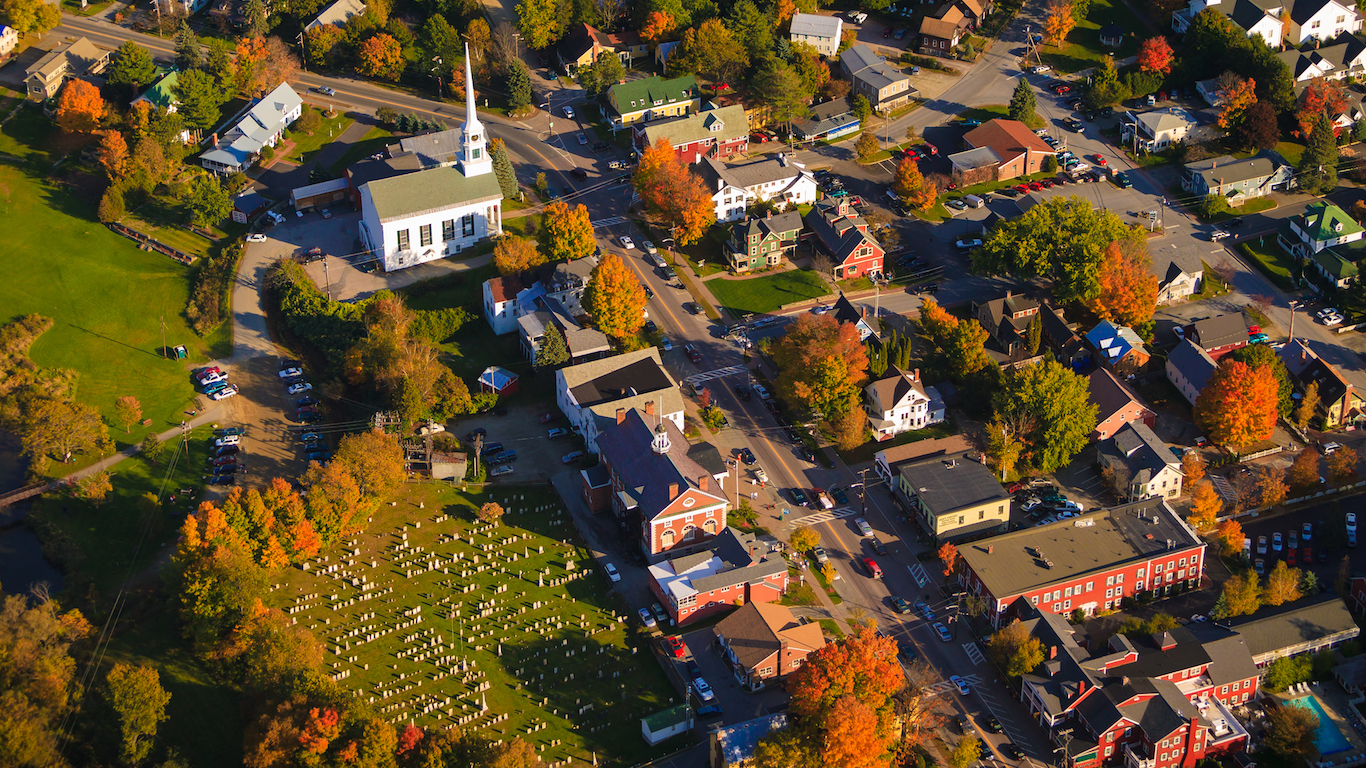
4. Vermont
> Adults who are “highly” religious: 34%
> Pct. of adults who pray daily: 33%
> Change, nonreligious share of population: N/A
Even though Vermont is not the least religious state in the country, its residents are some of the least impacted by religion. Less than a third of adults say religion is very important in their lives or that they pray daily, and only 21% of adults attend worship services at least once a week — both the lowest percentages of any state.
Vermont’s religious population is bolstered by the fact that 19% of its population are mainline Protestants, higher than in all but 10 other states. It is also tied for the eighth highest share of Jewish population.

3. Maine
> Adults who are “highly” religious: 34%
> Pct. of adults who pray daily: 35%
> Change, nonreligious share of population: +6 ppts
Studies show religion is becoming less important to Americans with each new generation. Americans born in the decades surrounding World War II are more likely to pray daily and believe in God than Generation Xers and Millennials. Maine, with a median age of 44.5 years old, has the oldest population in the country, but it is still one of the least religious.
Some 19.3% of Maine’s residents are 65 and older, the second-highest share. Despite the older population, only 34% of Maine adults consider religion very important, and just 22% worship on a weekly basis, some of the lower percentages among U.S. states.
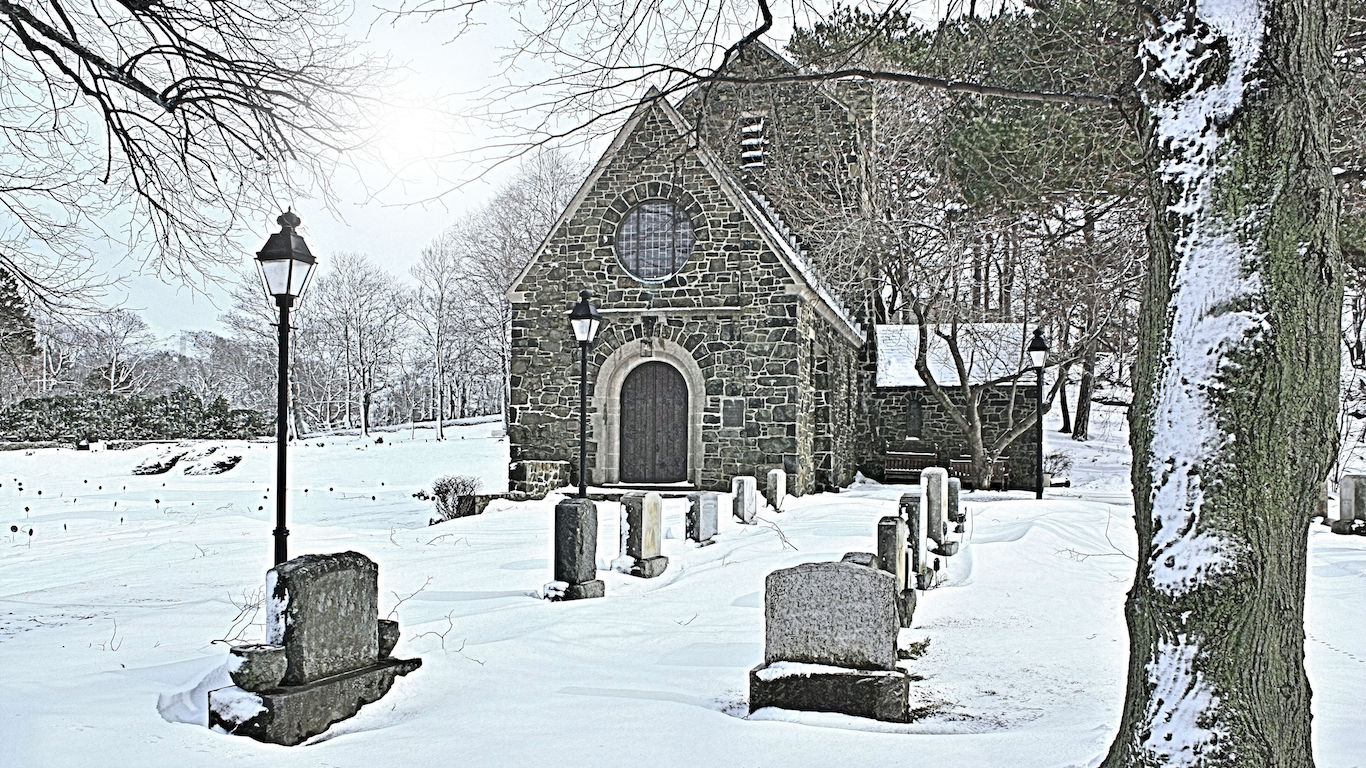
2. Massachusetts
> Adults who are “highly” religious: 33%
> Pct. of adults who pray daily: 37%
> Change, nonreligious share of population: +15 ppts
Massachusetts is home to one of the least religious populations in the country. Only 33% of Massachusetts residents say religion is important in their lives. While nearly 79% of adults considered themselves religious in 2007, only 65% felt the same in 2014. The number of nonreligious adults increased 15 percentage points in that same period.
While evangelical Christians are the most prominent religious group nationwide, only 9% of Massachusetts residents identify as such. Despite having one of the least religious populations in the U.S., the state is home to one of the largest Catholic populations in the nation thanks to the Irish and Italian roots of many of its people.
[in-text-ad-2]

1. New Hampshire
> Adults who are “highly” religious: 33%
> Pct. of adults who pray daily: 36%
> Change, nonreligious share of population: +9 ppts
New Hampshire is America’s least religious state with just 33% of adults saying they are highly religious. That is a far lower percentage than the U.S. average. Nationwide, 55% of adults say they are highly religious. New Hampshire is also dead last in the percentage of adults who believe in God with absolute certainty at 40%.
Despite these lower figures, most New Hampshire adults are Christian at 59%. Some 26% of adults in the state are Catholic, the largest group of Christians in the state and the ninth-highest percentage among states.
The last few years made people forget how much banks and CD’s can pay. Meanwhile, interest rates have spiked and many can afford to pay you much more, but most are keeping yields low and hoping you won’t notice.
But there is good news. To win qualified customers, some accounts are paying almost 10x the national average! That’s an incredible way to keep your money safe and earn more at the same time. Our top pick for high yield savings accounts includes other benefits as well. You can earn up to 3.80% with a Checking & Savings Account today Sign up and get up to $300 with direct deposit. No account fees. FDIC Insured.
Click here to see how much more you could be earning on your savings today. It takes just a few minutes to open an account to make your money work for you.
Thank you for reading! Have some feedback for us?
Contact the 24/7 Wall St. editorial team.